Pine
| Pine tree | |
|---|---|
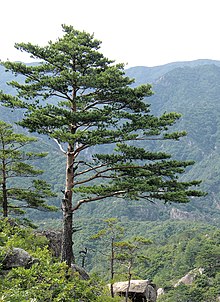 | |
Korean red pine (Pinus densiflora), North Korea | |
Scientific classification | |
| Kingdom: | Plantae |
| Division: | Pinophyta |
| Class: | Pinopsida |
| Order: | Pinales |
| Family: | Pinaceae |
| Subfamily: | Pinoideae |
| Genus: | Pinus L. |
| Subgenera | |
See List of Pinus species for complete taxonomy to species level. See list of pines by region for list of species by geographic distribution. | |
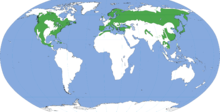 | |
| Range of Pinus | |
A pine is any conifer in the genus Pinus, /ˈpiːnuːs/,[1] of the family Pinaceae. Pinus is the sole genus in the subfamily Pinoideae. The Plant List compiled by the Royal Botanic Gardens, Kew and Missouri Botanical Garden accepts 126 species names of pines as current, together with 35 unresolved species and many more synonyms.[2]
Contents
1 Etymology
2 Description
2.1 Bark
2.2 Foliage
2.3 Cones
3 Taxonomy, nomenclature and codification
4 Distribution
5 Ecology
6 Uses
6.1 Lumber and construction
6.2 Ornamental uses
6.3 Wildlife
6.4 Farming
6.5 Food and nutrients
7 In popular culture
7.1 Literature
7.2 Art
7.3 Religious texts
8 See also
9 References
9.1 Bibliography
10 External links
Etymology

Pine forest in Vagamon, southern Western Ghats, Kerala (India)
The modern English name "pine" derives from Latin pinus, which some have traced to the Indo-European base *pīt- ‘resin’ (source of English pituitary).[3] Before the 19th century, pines were often referred to as firs (from Old Norse fura, by way of Middle English firre). In some European languages, Germanic cognates of the Old Norse name are still in use for pines—in Danish fyr, in Norwegian fura/fure/furu, Swedish fura/furu, Dutch vuren, and German Föhre—but in modern English, fir is now restricted to fir (Abies) and Douglas fir (Pseudotsuga).
Description

Ancient Pinus longaeva, Nevada, USA
Pine trees are evergreen, coniferous resinous trees (or, rarely, shrubs) growing 3–80 m (10–260 ft) tall, with the majority of species reaching 15–45 m (50–150 ft) tall. The smallest are Siberian dwarf pine and Potosi pinyon, and the tallest is an 81.79 m (268.35 ft) tall ponderosa pine located in southern Oregon's Rogue River-Siskiyou National Forest.[4]
Pines are long-lived, and typically reach ages of 100–1,000 years, some even more. The longest-lived is the Great Basin bristlecone pine, Pinus longaeva. One individual of this species, dubbed "Methuselah", is one of the world's oldest living organisms at around 4,600 years old. This tree can be found in the White Mountains of California.[5] An older tree, now cut down, was dated at 4,900 years old. It was discovered in a grove beneath Wheeler Peak and it is now known as "Prometheus" after the Greek immortal.[citation needed]
Bark

Pinus taeda bark
The bark of most pines is thick and scaly, but some species have thin, flaky bark. The branches are produced in regular "pseudo whorls", actually a very tight spiral but appearing like a ring of branches arising from the same point. Many pines are uninodal, producing just one such whorl of branches each year, from buds at the tip of the year's new shoot, but others are multinodal, producing two or more whorls of branches per year. The spiral growth of branches, needles, and cone scales may be arranged in Fibonacci number ratios.[citation needed] The new spring shoots are sometimes called "candles"; they are covered in brown or whitish bud scales and point upward at first, then later turn green and spread outward. These "candles" offer foresters a means to evaluate fertility of the soil and vigour of the trees.
Foliage
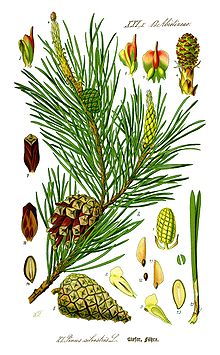
Illustration of needles, cones, and seeds of Scots pine (Pinus sylvestris)
Pines have four types of leaf:
- Seed leaves (cotyledons) on seedlings are borne in a whorl of 4–24.
- Juvenile leaves, which follow immediately on seedlings and young plants, are 2–6 cm long, single, green or often blue-green, and arranged spirally on the shoot. These are produced for six months to five years, rarely longer.
- Scale leaves, similar to bud scales, are small, brown and not photosynthetic, and arranged spirally like the juvenile leaves.
- Needles, the adult leaves, are green (photosynthetic) and bundled in clusters called fascicles. The needles can number from one to seven per fascicle, but generally number from two to five. Each fascicle is produced from a small bud on a dwarf shoot in the axil of a scale leaf. These bud scales often remain on the fascicle as a basal sheath. The needles persist for 1.5–40 years, depending on species. If a shoot is damaged (e.g. eaten by an animal), the needle fascicles just below the damage will generate a bud which can then replace the lost leaves.
Cones

A growing female cone of a Scots pine on a mountain in Perry County, Pennsylvania.

A fully grown and freshly fallen female pine cone (pinus strobus.)
Pines are mostly monoecious, having the male and female cones on the same tree, though a few species are sub-dioecious, with individuals predominantly, but not wholly, single-sex. The male cones are small, typically 1–5 cm long, and only present for a short period (usually in spring, though autumn in a few pines), falling as soon as they have shed their pollen. The female cones take 1.5–3 years (depending on species) to mature after pollination, with actual fertilization delayed one year. At maturity the female cones are 3–60 cm long. Each cone has numerous spirally arranged scales, with two seeds on each fertile scale; the scales at the base and tip of the cone are small and sterile, without seeds. The seeds are mostly small and winged, and are anemophilous (wind-dispersed), but some are larger and have only a vestigial wing, and are bird-dispersed (see below). At maturity, the cones usually open to release the seeds, but in some of the bird-dispersed species (e.g. whitebark pine), the seeds are only released by the bird breaking the cones open. In others, the seeds are stored in closed ("serotinous") cones for many years until an environmental cue triggers the cones to open, releasing the seeds. The most common form of serotiny is pyriscence, in which a resin binds the cones shut until melted by a forest fire.
Taxonomy, nomenclature and codification
Pines are gymnosperms. The genus is divided into two subgenera, which can be distinguished by cone, seed, and leaf characters:
Pinus subg. Pinus, the yellow, or hard pine group, generally with harder wood and two or three needles per fascicle[6]
Pinus subg. Strobus, the white, or soft pine group, generally with softer wood and five needles per fascicle[6]
Distribution

A Khasi pine in Benguet, Philippines

Huangshan pine (Pinus hwangshanensis), Anhui, China
Pines are native to the Northern Hemisphere, and in a few parts of the tropics in the Southern Hemisphere. Most regions of the Northern Hemisphere (see List of pines by region) host some native species of pines. One species (Sumatran pine) crosses the equator in Sumatra to 2°S. In North America, various species occur in regions at latitudes from as far north as 66°N to as far south as 12°N.[citation needed]
Pines may be found in a very large variety of environments, ranging from semi-arid desert to rainforests, from sea level up to 5,200 metres (17,100 ft), from the coldest to the hottest environments on Earth. They often occur in mountainous areas with favorable soils and at least some water.[citation needed]
Various species have been introduced to temperate and subtropical regions of both hemispheres, where they are grown as timber or cultivated as ornamental plants in parks and gardens. A number of such introduced species have become naturalized, and some species are considered invasive in some areas[7] and threaten native ecosystems.
Ecology
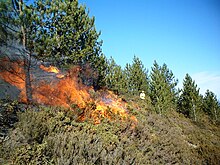
A prescribed fire in a European black pine (Pinus nigra) woodland, Portugal

Pine cone
Pines grow well in acid soils, some also on calcareous soils; most require good soil drainage, preferring sandy soils, but a few (e.g. lodgepole pine) can tolerate poorly drained wet soils. A few are able to sprout after forest fires (e.g. Canary Island pine). Some species of pines (e.g. bishop pine) need fire to regenerate, and their populations slowly decline under fire suppression regimens. Several species are adapted to extreme conditions imposed by elevation and latitude (e.g. Siberian dwarf pine, mountain pine, whitebark pine, and the bristlecone pines). The pinyon pines and a number of others, notably Turkish pine and gray pine, are particularly well adapted to growth in hot, dry semidesert climates.[citation needed]
The seeds are commonly eaten by birds, such as grouse, crossbills, jays, nuthatches, siskins, and woodpeckers, and by squirrels. Some birds, notably the spotted nutcracker, Clark's nutcracker, and pinyon jay, are of importance in distributing pine seeds to new areas. Pine needles are sometimes eaten by some Lepidoptera (butterfly and moth) species (see list of Lepidoptera that feed on pines), the Symphytan species pine sawfly, and goats.[citation needed]
Pine pollen may play an important role in the functioning of detrital food webs.[8] Nutrients from pollen aid detritivores in development, growth, and maturation, and may enable fungi to decompose nutritionally scarce litter.[8] Pine pollen is also involved in moving plant matter between terrestrial and aquatic ecosystems.[8]
Uses

Logging Pinus ponderosa, Arizona, USA
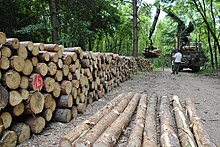
Pinus sylvestris prepared for transport, Hungary
Lumber and construction

Tongue and groove solid pine flooring
Pines are among the most commercially important tree species valued for their timber and wood pulp throughout the world.[9][10] In temperate and tropical regions, they are fast-growing softwoods that grow in relatively dense stands, their acidic decaying needles inhibiting the sprouting of competing hardwoods. Commercial pines are grown in plantations for timber that is denser, more resinous, and therefore more durable than spruce (Picea). Pine wood is widely used in high-value carpentry items such as furniture, window frames, panelling, floors, and roofing, and the resin of some species is an important source of turpentine.
Because pines have no insect- or decay-resistant qualities after logging, they are generally recommended for construction purposes as indoor use only (ex. indoor drywall framing). This wood left outside can be expected to last no more than 12–18 months depending on the local climate. It is commonly referred to by several different names which include North American timber, spruce/pine/fir (SPF), and whitewood.
Ornamental uses
Many pine species make attractive ornamental plantings for parks and larger gardens with a variety of dwarf cultivars being suitable for smaller spaces. Pines are also commercially grown and harvested for Christmas trees. Pine cones, the largest and most durable of all conifer cones, are craft favorites. Pine boughs, appreciated especially in wintertime for their pleasant smell and greenery, are popularly cut for decorations.[11] Pine needles are also used for making decorative articles such as baskets, trays, pots, etc, and during the U.S. Civil War, the needles of the longleaf pine "Georgia pine" were widely employed in this.[12] This originally Native American skill is now being replicated across the world. Pine needle handicrafts are made in the US, Canada, Mexico, Nicaragua, and India.
Wildlife
Pine needles serve as food for various Lepidoptera. See List of Lepidoptera that feed on pines. Several species are attacked by nematodes, causing pine wilt disease, which can kill some quickly.
Farming
When grown for sawing timber, pine plantations can be harvested after 30 years, with some stands being allowed to grow up to 50 (as the wood value increases more quickly as the trees age). Imperfect trees (such as those with bent trunks or forks, smaller trees, or diseased trees) are removed in a "thinning" operation every 5–10 years. Thinning allows the best trees to grow much faster, because it prevents weaker trees from competing for sunlight, water, and nutrients. Young trees removed during thinning are used for pulpwood, while most older ones are good enough for saw timber.
The final wood quality can be improved by pruning small branches at ages 5, 7, and 9. Pruning usually goes up to a height of 6 metres (20 ft). This results in smooth timber with no knots, which is considerably more valuable.
[13]
A 30-year-old commercial pine tree grown in good conditions will be about 0.3 m (1.0 ft) in diameter and about 20 m (66 ft) high. After 50 years, the same tree will be about 0.5 m (1.6 ft) in diameter and 25 m (82 ft) high, and its wood will be worth about seven times as much as the 30-year-old tree.
[14]
Trees are planted 3–4 m apart, or about 1000 per hectare (100,000 per km2).
Food and nutrients

Edible seeds of the Korean pine (Pinus koraiensis)
Some species have large seeds, called pine nuts, that are harvested and sold for cooking and baking. They are an essential ingredient of pesto alla genovese.
The soft, moist, white inner bark (cambium) found clinging to the woody outer bark is edible and very high in vitamins A and C. It can be eaten raw in slices as a snack or dried and ground up into a powder for use as an ersatz flour or thickener in stews, soups, and other foods, such as bark bread. Adirondack Indians got their name from the Mohawk Indian word atirú:taks, meaning "tree eaters".
A tea made by steeping young, green pine needles in boiling water (known as tallstrunt in Sweden) is high in vitamins A and C. In eastern Asia, pine and other conifers are accepted among consumers as a beverage product, and used in teas, as well as wine.[15]
Pine needles from Pinus densiflora were found to contain 30.54 mg/g of proanthocyanidins when extracted with hot water.[16] Comparative to ethanol extraction resulting in 30.11 mg/g, simply extracting in hot water is preferable.
Proanthocyanidins, the nutrient for which wine and grapes are famed and grapeseed extract is used medicinally,[17] is in nearly the same quantity in pine needles of P. densiflora as it is in grape juice (35 mg/g). Grapeseed extract from cultivated grapes is 48.9 to 96.7 mg/g.[18]
In popular culture

By Camille Pissarro.
Pines have been a frequently mentioned tree throughout history, including in literature, paintings and other art, and in religious texts.
Literature
Writers of various nationalities and ethnicities have written of pines. Among them, John Muir,[19]Dora Sigerson Shorter,[20]Eugene Field,[21] the Chinese,[22]Theodore Winthrop,[23] and Rev. George Allan D.D.[24]
Art
Pines are often featured in art, whether painting and fine art,[25] drawing,[26] photography, or folk art.
Religious texts
Pine trees, as well as other conifers, are mentioned in The Bible. In Nehemiah 8:15, the King James Version renders the following translation:[27]
"And that they should publish and proclaim in all their cities, and in Jerusalem, saying, Go forth unto the mount, and fetch olive branches, and pine branches [emphasis added], and myrtle branches, and palm branches, and branches of thick trees, to make booths, as it is written."
Pines are also mentioned in Isaiah 41:
"17: When the poor and needy seek water, and there is none, and their tongue faileth for thirst, I the LORD will hear them, I the God of Israel will not forsake them. 18: I will open rivers in high places, and fountains in the midst of the valleys: I will make the wilderness a pool of water, and the dry land springs of water. 19: I will plant in the wilderness the cedar, the shittah tree, and the myrtle, and the oil tree; I will set in the desert the fir tree, and the pine, and the box tree together: 20: That they may see, and know, and consider, and understand together, that the hand of the LORD hath done this, and the Holy One of Israel hath created it."
And in Isaiah 60:
"13: The glory of Lebanon shall come unto thee, the fir tree, the pine tree, and the box together, to beautify the place of my sanctuary; and I will make the place of my feet glorious."
See also
- Pine barrens
- Pine-cypress forest
- Three Friends of Winter
- El Pino (The Pine Tree)
- Tree of Peace
- List of pines by region
References
^ Sunset Western Garden Book, 1995:606–607
^ "The Plant List Version 1.1". Retrieved 15 December 2015.
^ "Where Are You From? - Credo Reference". credoreference.com.
^ Fattig, Paul (2011-01-23). "Tallest of the tall". Mail Tribune. Medford, Oregon. Archived from the original on 2013-02-21. Retrieved 2011-01-27.
^ Ryan, Michael; David M. Richardson (December 1999). "The Complete Pine". BioScience. 49 (12): 1023–1024. doi:10.2307/1313736.
^ ab Burton Verne Barnes; Warren Herbert Wagner (January 2004). Michigan Trees: A Guide to the Trees of the Great Lakes Region. University of Michigan Press. pp. 81–. ISBN 0-472-08921-8. Archived from the original on 2016-05-11.
^ "Pinus ssp. (tree), General Impact". Global Invasive Species Database. Invasive Species Specialist Group. 13 March 2006. Archived from the original on 26 July 2011. Retrieved 2 March 2011.
^ abc Filipiak, Michał (2016-01-01). "Pollen Stoichiometry May Influence Detrital Terrestrial and Aquatic Food Webs". Behavioral and Evolutionary Ecology. 4: 138. doi:10.3389/fevo.2016.00138. Archived from the original on 2016-12-21.
^ "Choosing a Timber Species - Timber Frame HQ". Timber Frame HQ. Retrieved 2018-01-04.
^ "Trees for pulp" (PDF). Paper.org.
^ "5 Ways to Decorate with Pine Boughs". Home Decorating Trends - Homedit. 2012-12-04. Retrieved 2018-01-04.
^ McAfee, M. J. (Mary Jane) (1911). The pine-needle basket book. The Library of Congress. New York : Pine-Needle Pub. Co.
^ "The Pine Plantation Rotation" (PDF). Forests NSW. Archived (PDF) from the original on 2016-03-08. Retrieved 1 April 2016.
^ Frank A. Roth II, Extension Forester. "Thinning to improve pine timber" (PDF). University of Arkensas Division of Agriculture. Archived from the original (PDF) on 2016-10-09. Retrieved April 2016. Check date values in:|accessdate=(help)
^ Zeng WC, Jia LR, Zhang Y, Cen JQ, Chen X, Gao H, Feng S, Huang YN. 2011. Antibrowning and antimicrobial activities of the water-soluble extract from pine needles of Cedrus deodara. J Food Sci 76: C318-C323
^ Park YS, Jeon MH, Hwang HJ, Park MR, Lee SH, Kim SG, Kim M (August 2011). "Antioxidant activity and analysis of proanthocyanidins from pine (Pinus densiflora) needles". Nutrition Research and Practice. 5 (4): 281–7. doi:10.4162/nrp.2011.5.4.281. PMC 3180677 . PMID 21994521.
. PMID 21994521.
^ "Grapes". www.raysahelian.com. Retrieved 2017-12-21.
^ Trad, Mehdi; Bourvellec, Carine Le; Hamda, Hmida Ben; Renard, Catherine M. G. C.; Harbi, Mounira (2017-11-01). "Flavan-3-ols and procyanidins in grape seeds: biodiversity and relationships among wild and cultivated vines". Euphytica. 213 (11): 242. doi:10.1007/s10681-017-2032-z. ISSN 0014-2336.
^ Muir, John. The Yosemite.
^ Shorter, Dora Sigerson. The Secret.
^ Field, Eugene. Poems of Childhood/Norse Lullaby.
^ Juyi, Bai. More Translations from the Chinese.
^ Winthrop, Theodore. Life in the Open Air.
^ The Book of Scottish Song.
^ Pissarro, Camille (before 1903), Work by Camille Pissarro, retrieved 1 April 2018 Check date values in:|date=(help)
^ 60, USDA-NRCS PLANTS Database / Britton, N. L., and A. Brown 1913 Illustrated flora of the northern states and Canada Vol 1: (1913), Pinus strobus L., retrieved 2018-01-04
^ "NEHEMIAH 8:15 KJV "And that they should publish and proclaim in all their cities, and in Jerusalem, saying, Go forth unto..."". www.kingjamesbibleonline.org. Retrieved 2018-01-04.
Bibliography
.mw-parser-output .refbeginfont-size:90%;margin-bottom:0.5em.mw-parser-output .refbegin-hanging-indents>ullist-style-type:none;margin-left:0.mw-parser-output .refbegin-hanging-indents>ul>li,.mw-parser-output .refbegin-hanging-indents>dl>ddmargin-left:0;padding-left:3.2em;text-indent:-3.2em;list-style:none.mw-parser-output .refbegin-100font-size:100%
- Farjon, A. 1984, 2nd edition 2005. Pines. E. J. Brill, Leiden. ISBN 90-04-13916-8
- Little, E. L., Jr., and Critchfield, W. B. 1969. Subdivisions of the Genus Pinus (Pines). US Department of Agriculture Misc. Publ. 1144 (Superintendent of Documents Number: A 1.38:1144).
- Richardson, D. M. (ed.). 1998. Ecology and Biogeography of Pinus. Cambridge University Press, Cambridge. 530 p. ISBN 0-521-55176-5
- Sulavik, Stephen B. 2007. Adirondack; Of Indians and Mountains, 1535-1838. Purple Mountain Press, Fleischmanns, NY. 244 p. ISBN 1-930098-79-0 ISBN 978-1-930098-79-4
- Mirov, N. T. 1967. The Genus Pinus. Ronald Press, New York (out of print).
"Classification of pines". The Lovett Pinetum Charitable Foundation.
Earle, Christopher J., ed. (2018). "Pinus". The Gymnosperm Database.
Mirov, N. T.; Stanley, R. G. (1959). "The Pine Tree". Annual Review of Plant Physiology. 10: 223. doi:10.1146/annurev.pp.10.060159.001255.- Philips, Roger. Trees of North America and Europe, Random House, Inc., New York ISBN 0-394-50259-0, 1979.
External links
| Wikimedia Commons has media related to Pinus. |
40 Pine Trees From Around the World by The Spruce
Key to Pinus from the Jepson Manual, covers Californian species- Pinus in Flora of North America
- Pinus in the USDA Plants Database

 Clash Royale CLAN TAG#URR8PPP
Clash Royale CLAN TAG#URR8PPP